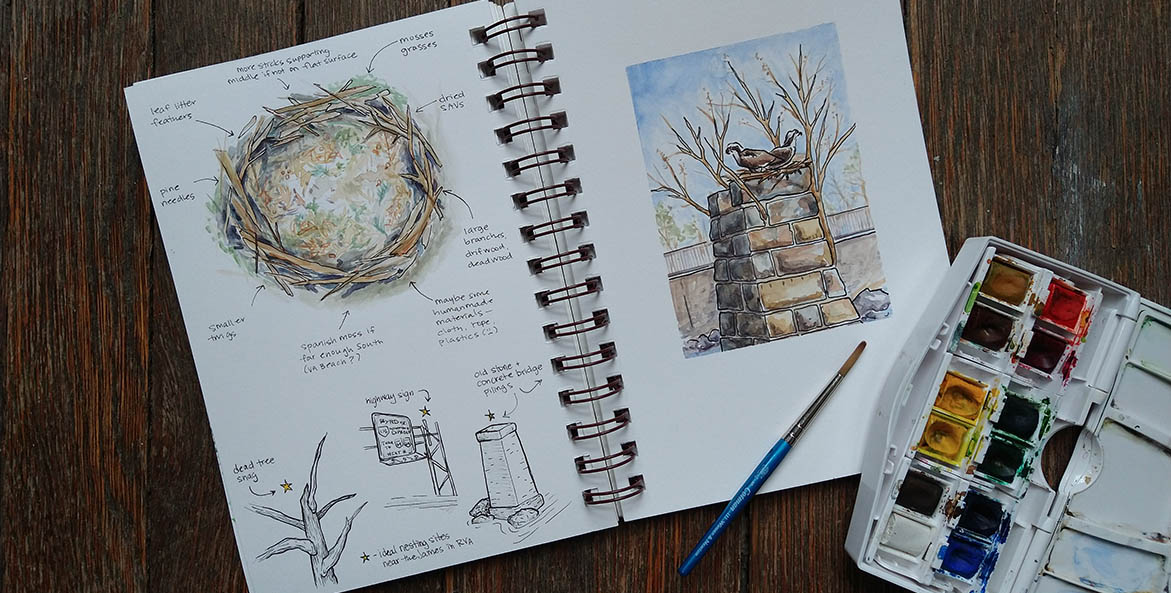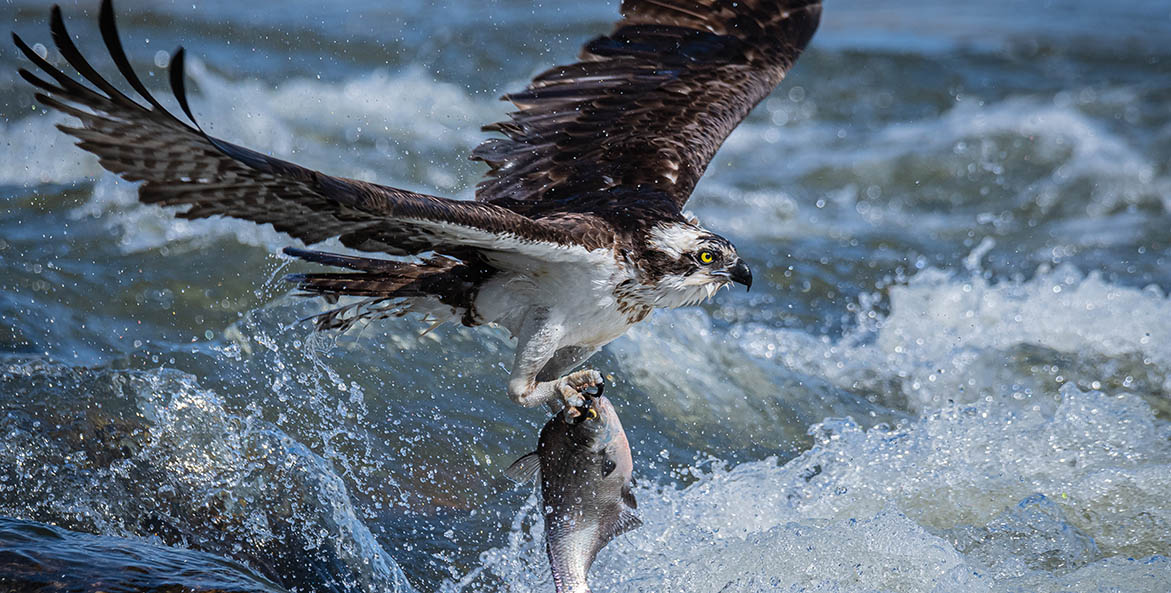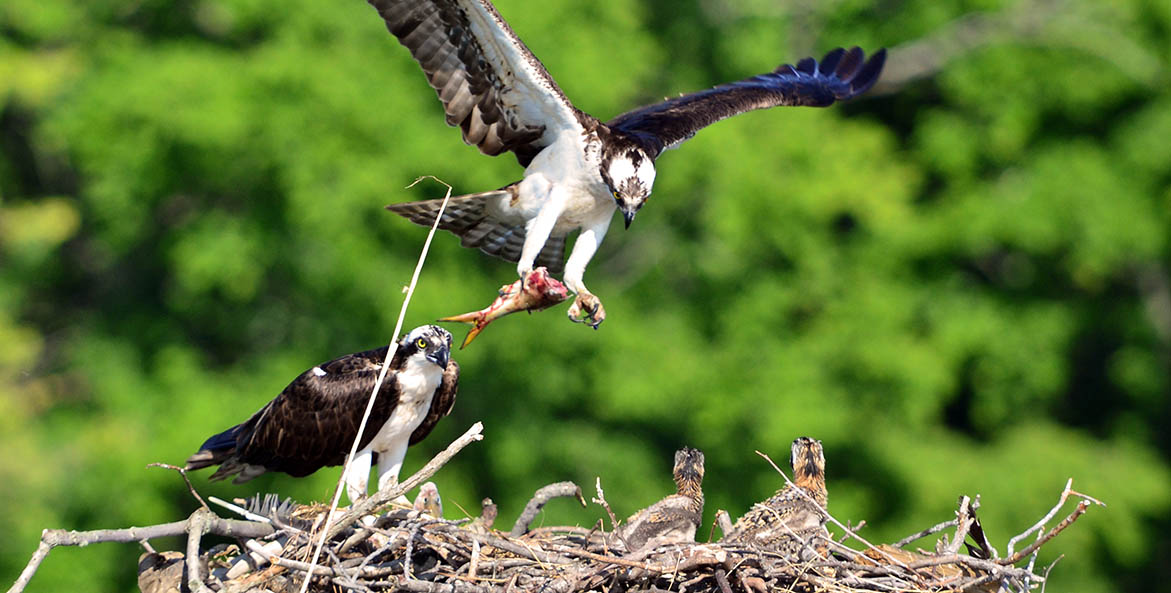See the complete Nature Journaling series.
Ospreys are back! These familiar Bay birds, often referred to as fish hawks, are known for their hunting prowess while tracking down their snack of choice. Like most fisherfolk, osprey love to boast about their fishing conquests. Spiraling high above the waterways, you'll hear them proudly call attention to whatever fish is aerodynamically clutched in their talons. These playful whistles may resemble the excited squeals of a toddler who has learned to open the cookie jar, but ospreys deserve a hearty celebration after their long return trip north. Their chipper calls are also a welcome sign of spring.
After spending the winter in warmer locales, mating pairs reunite at their nesting sites for the true business of spring—breeding. Unlike many birds, successful osprey parents return to the same nest year after year, expanding its edges and relining the interior. From a human perspective, osprey nests look haphazard. A wide jumble of sticks and grasses perched atop a marine channel marker, highway sign, or dead tree may not seem like the best place for these cunning raptors. However, ospreys strategically place their nests near waterways with a clear view of their surroundings. The birds are also talented gatherers, choosing materials suited best for nest construction. Juvenile osprey will even "play house" to develop the nest-building skills they will need later in life. A tangle of twigs to the human eye is a sight for sore eyes for the returning, iconic osprey.
Keep your eyes to the sky over the coming weeks. Listen for the proud chirps that signal a successful hunt. Enjoy the dizzying, sky-high dances of a reunited mating pair. Spot a fuzzy-headed fledgling eyeing the world from the comfort of its nest. Welcome the fish hawks home!

Kathlean Davis
Art Prompt: Build Your Nest
Materials Needed: nature journal or paper, pen or pencil, coloring materials* (*optional)
Assignment: After years of decline, osprey populations are beginning to rebound. However, chemical contaminants and loss of nesting areas continue to threaten successful breeding. Proactive bird lovers have taken it upon themselves to provide additional nesting structures for this iconic species.
Whether or not your home is near a waterway, go on a walk and identify good nesting structures for migrating osprey. Select locations that are high off the ground with a clear view of the surrounding area. Trees are ideal spots, but ospreys will often use manmade structures, like highway signs, too.
In your nature journal, sketch the nesting sites you found on your walk. Design a nest for one of your sites. Include the building materials you would use, paying special attention to the softer lining of the nest. What local materials do you think an osprey would use to build their nest? Compare your nest design to images of osprey nests online.
Additional Resources:
- National Audobon Society, Fish Hawk, or Osprey
- The Cornell Lab of Ornithology, NestWatch
- Scientific American, Build a Bird Nest
Further Questions: What manmade materials would be good nest-building materials? What manmade materials could harm juvenile osprey? What can you do in your community to protect the osprey population?

Osprey fishing in the rapids of the Rappahannock River in Fredericksburg VA.
Edward S. Episcopo
Writing Prompt: Bay Cam Chit Chat
Materials Needed: Internet-accessible device, nature journal or paper, pen or pencil
Assignment: Visit CBF's live Bay Cam using your internet-accessible device. Spend some time observing the nest site. Record what you see. What species are present? How many species are there? How are they behaving? What is the weather like? What time of day is it?
After recording your observations, write a dialogue for the animals during the time you observed them. If there was only one organism present, you can develop an internal dialogue. If there were no organisms present, write from the perspective of the nest itself. Consider what the organisms are doing, what they may be thinking, or what their future plans may be.
Additional Resources:
Further Questions: After researching the species you observed, when are they most active and what are some common behaviors? What are the major threats to this species? How did considering the thoughts of this organisms change your feelings about the species?
Check out more Nature Journaling prompts.



